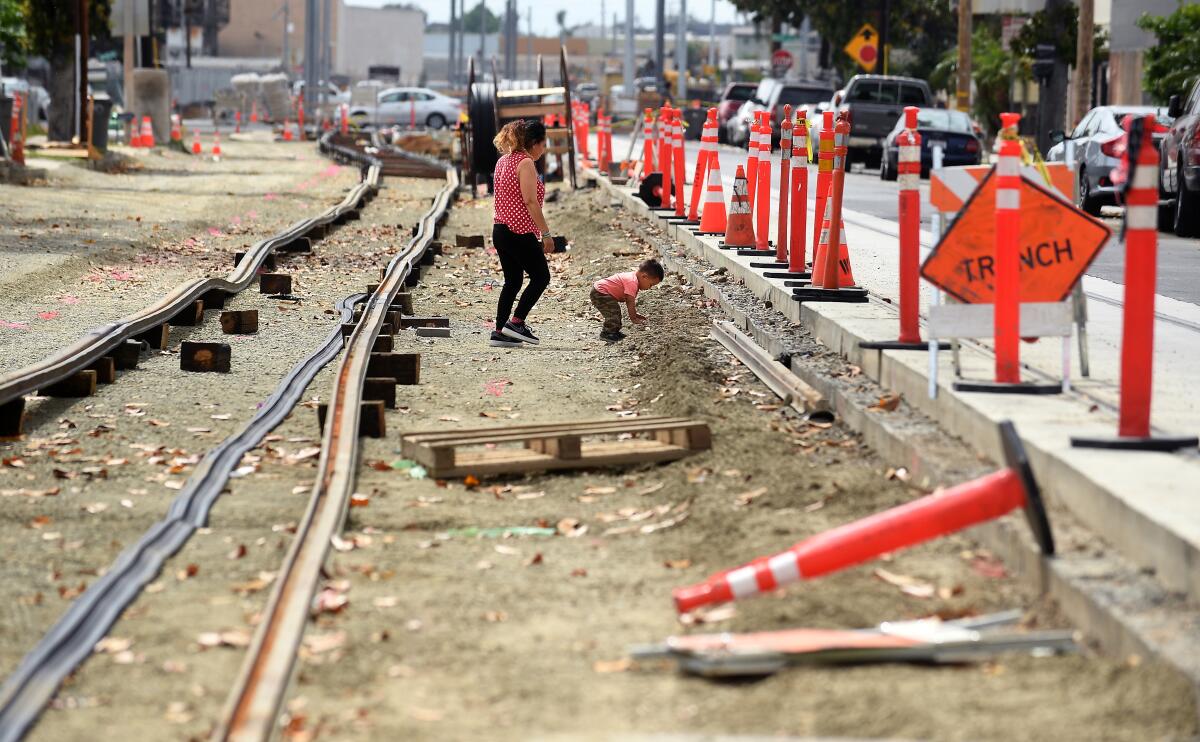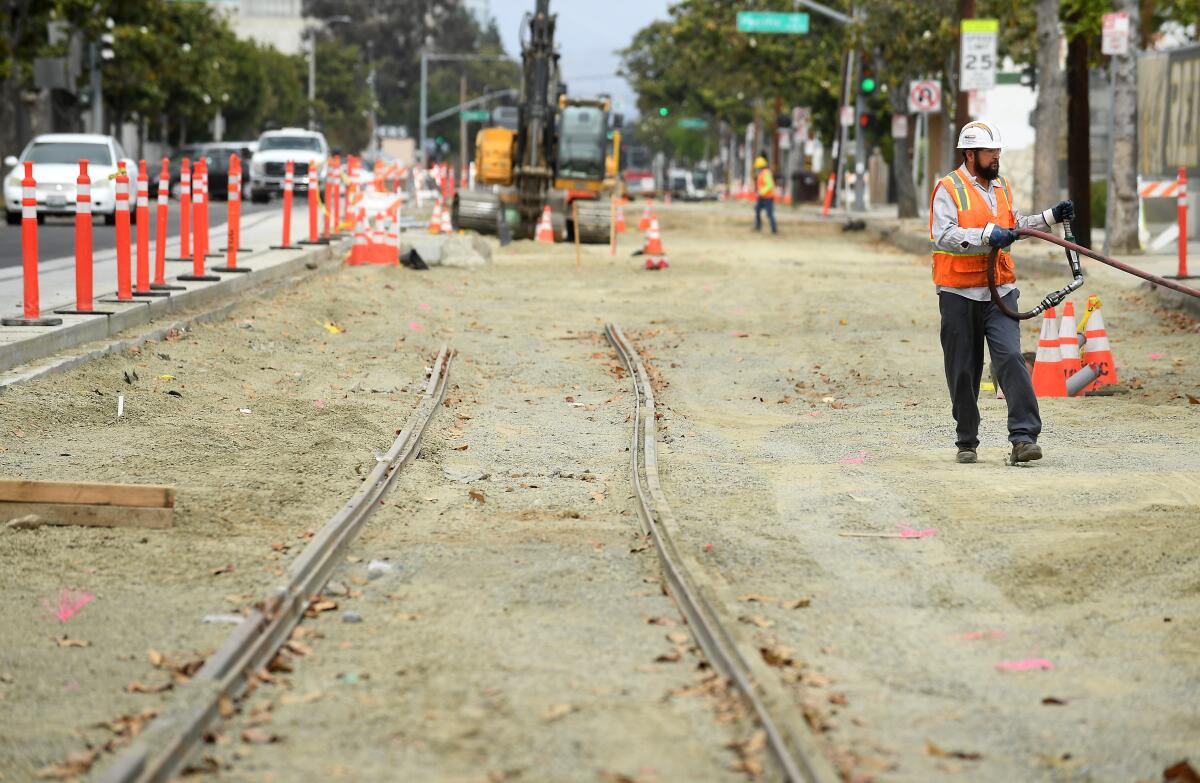After decades of fighting and freeways, Orange County is finally getting a streetcar

- Share via
As metropolitan areas around California were building urban rail systems over the last few decades, one was a notable holdout: Orange County.
San Jose, Sacramento, San Diego and even the North Bay constructed rail lines, adding to bigger systems in the Bay Area and Los Angeles County. But Orange County stuck by the car, constructing an extensive network of toll roads through the booming east and south county areas. Proposals for urban rail systems came and went, failing to generate much support and demonized by critics as a waste of taxpayer money.
But with traffic worsening and rail gaining traction — particularly among young people — the county is finally about to take a ride, albeit a short one.
The OC Streetcar system, a $423-million project slated for completion in 2023, will comprise only six light-rail vehicles and will cover a bit more than four miles, linking the Santa Ana Regional Transportation Center to strip-mall-lined streets near Little Saigon.
While OC Streetcar’s development is a milestone, the public’s acceptance of it is largely due to its small footprint, experts say. The track is significantly shorter than those of previously proposed light-rail projects. And it’s being built in a largely dense and working-class area, away from the county’s upscale neighborhoods.
In short, the trains will offer transit options without entering most of the county’s suburban enclaves. Yet the project does indicate a change in attitude that comes at a time when the county is under pressure to embrace denser development to address California’s shortage of housing.
“There’s a growing recognition that Orange County has become more like Gotham City and less like Mayberry, and people are beginning to realize the private automobile alone is not going to work for us,” said Fred Smoller, an associate professor of political science at Chapman University in Orange. “There’s a greater acceptance for other types of transportation.”
The development of OC Streetcar comes after decades of freeway improvements and the construction of toll roads from Yorba Linda in the north to San Juan Capistrano in the south. The county is in the middle of a $1.9-billion project to widen the 405 Freeway. But some officials acknowledge that there are limits to how much more capacity they can squeeze out of road projects.
“You can’t widen freeways forever,” said Miguel Pulido, a former Orange County Transportation Authority board member and former mayor of Santa Ana. “It’s not only the monetary cost, but at the end of the day, what do you want society to look like?”
The final leg of the Metro subway that eventually will take riders from downtown L.A. into the Westside broke ground on Monday.
More than a decade ago, Orange County transportation officials shelved plans for a larger, billion-dollar light-rail system that would have connected several cities with John Wayne Airport.
Plans for the CenterLine project — originally a 28-mile track that would run between Fullerton and Irvine — were first drafted in the 1990s, but the light-rail system that was touted as a symbol of Orange County’s urban maturity became so contentious that it was scaled down before ultimately being scrapped.
“I think it took a long time to convince people in Orange County that there was a need for it, that there was room for it and that it’s worth the money and the investment,” Sarah Catz, a researcher in the Institute of Transportation Studies at UC Irvine and a former OCTA board member, said of light rail.
Transit officials billed CenterLine as a necessary step in keeping up with Orange County’s projected growth, but residents in cities where tracks were to be laid pushed back with complaints that the system would destroy the feel of their neighborhoods, waste transportation dollars and do little to stem traffic and air pollution.
In 1999, a Santa Ana resident attending a transportation meeting about CenterLine blew a train whistle during the public comment period to convey just how disruptive the trains would be to his quiet quality of life.

That resistance started eroding, however, under the weight of the county’s rapidly shifting demographics. In 1990, Orange County had just over 2.4 million residents. Thirty years later, 3.2 million people call it home — making it the third most-populous county in California, behind Los Angeles and San Diego.
Much of that growth was in cities in north and central Orange County, where an increasing number of politicians and residents now see the potential for at least portions of the county to move away from their deeply entrenched reliance on cars.
“I think maybe some of those ideas two or three decades ago were maybe a little bit before their time,” said Darrell Johnson, OCTA’s chief executive. “I think that the idea of how transportation and transit works, being married up with sort of the modern thinking, and the reality of the denseness of the center of our county, they’re coming together.”
In the years following CenterLine’s demise, the region focused on freeway-widening projects and expanding the network of bus routes and Amtrak and Metrolink services.
The new streetcar will provide commuters with a link to the region’s other public transit systems. Someone who lives in South Orange County and needs to get to downtown Santa Ana, for example, could take Metrolink to the Santa Ana train station and get to the downtown area without driving on the 5 Freeway and hassling with parking, Johnson said.
Construction of the streetcar has been an added nuisance for residents and downtown business owners who have struggled during the pandemic. Some fear that it might speed up gentrification in a region that has already seen many longtime businesses close.
“Everything is changing,” said Gladys Rodriguez, 18, a Santa Ana native. “There used to be a lot of family restaurants and stores, and now there’s bars on every corner. Whenever something new comes in, it just drives old businesses out.”
Other residents are more welcoming of the transit line. Anthony Lara, 60, a longtime Santa Ana resident, hopes access to public transportation will ease parking woes resulting from mixed-use developments that have sprung up in aging warehouses along Santiago Street and Santa Ana Boulevard.
But he worries that the streetcar’s limited route might make it ineffective for commuters.
“Personally, I don’t think the line is long enough,” he said. “I figure more people would use it if it went farther.”
L.A.’s trillion-dollar rail boom has so far showed mixed results. Everyone is looking for a game changer. Will rail to LAX be it?
Not everyone is convinced the project will deliver on its lofty promise to relieve congestion. Calling it a “boondoggle,” the Orange County Register’s editorial board in late 2020 said officials should prioritize “cost-effective transportation-engineering projects such as roads and buses rather than social-engineering projects that attempt to change the way we get around.”
The bulk of the streetcar’s funding — about $225 million — was provided by the federal government. Voters kicked in $172.8 million as part of Measure M, a half-cent sales tax for transportation improvements, and the state provided $25.5 million, according to OCTA.
“Public transportation, in my mind, is not the answer to all the things people say it is,” said Orange County Supervisor Don Wagner, who sits on the OCTA board. “They say it’s the answer to overcrowding, the answer to global warming and carbon emissions, and it’s just not. Not enough people use it.”
No additional transit routes are being studied, but some politicians envision the OC Streetcar eventually spanning the county, from Disneyland to John Wayne Airport.
Brock Shingledecker, 23, who works at a coffee shop on Santa Ana Boulevard, is looking forward to the option of hopping on the rail line after work to grab dinner in downtown Santa Ana. He’s just not sure if it will catch on with everyone.
“All in all, I think the streetcar could add a lot to the local economy,” he said. “It could potentially be really good, but I guess time will tell.”
More to Read
Sign up for Essential California
The most important California stories and recommendations in your inbox every morning.
You may occasionally receive promotional content from the Los Angeles Times.















